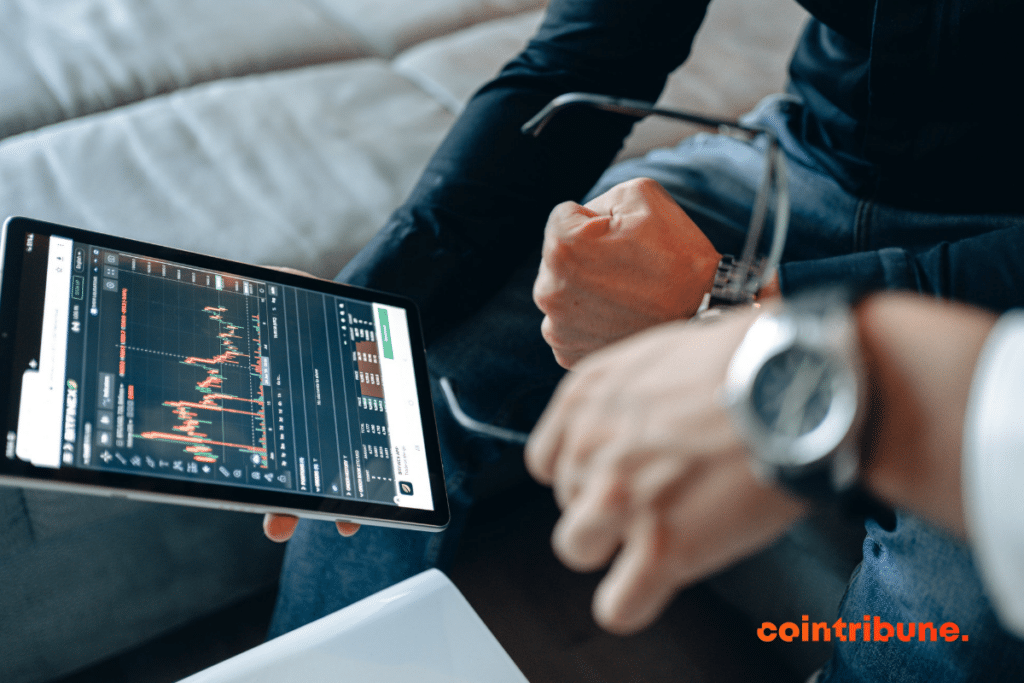How to Manage Risk in Trading?
Trading, with its fluctuations and uncertainties, calls for rigorous risk management to ensure the sustainability and profitability of investments. Faced with a volatile and unpredictable market, understanding and mastering the different types of risk is important for protecting capital and maximizing gains. This article sets out the strategies for effective risk management in trading.

The different types of trading risk
There are three main types of risk in trading: market risk, liquidity risk and leverage risk. Each of these risks has unique characteristics and requires a specific approach for effective management.
Market risk
Market risk is inherent in all forms of trading. It refers to the unpredictable fluctuations in asset prices on the financial markets. These variations can be influenced by a multitude of factors, such as political changes, economic announcements or natural disasters.
Global events, such as central bank monetary policy decisions or geopolitical tensions, can lead to significant market movements. For example, a rise in interest rates can reduce the attractiveness of equities, impacting their value. Volatility is a measure of the intensity and frequency of price variations. High volatility means that the price of an asset can change rapidly in a short period of time, increasing the risk of losses, but also offering opportunities for gains for informed traders.
To manage this risk, traders often use technical and fundamental analysis to anticipate market trends. They may also resort to diversification to reduce the impact of adverse movements in a specific market.
Liquidity risk
Liquidity risk arises when a trader cannot buy or sell an asset quickly without causing a significant impact on its price. This risk is particularly prevalent in markets where assets are traded less frequently.
Some assets, such as small company shares or exotic currencies, may have less liquid markets. This means that trading volumes are low, making it difficult to sell or buy these assets quickly without affecting their price.
The spread between the buy (bid) and sell (ask) price of an asset is a key indicator of liquidity. A wide spread often indicates low liquidity, increasing the risk for traders who may not be able to close their positions at the desired price.
To manage liquidity risk, traders can focus on more liquid assets or use limit orders, which control the price at which the asset is bought or sold. Constant market monitoring and an understanding of optimal trading hours are also crucial.
Leverage risk
Financial leverage enables traders to increase their exposure to the market using borrowed funds. While this can amplify gains, it also increases the risk of losses. Leverage allows traders to control a larger position with less initial capital. However, it also means that losses can exceed initial capital, resulting in large debts.
The use of leverage often involves margin requirements, where traders must maintain a certain amount of funds in their account to cover their positions. A market downturn can result in margin calls, forcing the trader to add funds or close positions. Managing leverage risk requires great caution. Traders must fully understand the implications of leverage and use risk management strategies, such as stop-loss orders, to protect their capital. A good rule of thumb is to use leverage only within well-understood limits and with a clear strategy.

Basic risk management strategies
Risk management is a fundamental pillar of trading. For both novice and experienced traders, adopting basic risk management strategies is essential to successfully navigating the financial markets. These strategies include the use of stop-loss and take-profit orders, as well as portfolio diversification.
Using stop-loss orders
Stop-loss orders are crucial tools for limiting potential losses in trading. They enable traders to define a specific price level at which a position will be automatically closed, thus limiting losses if the market moves unfavorably. A stop-loss order is placed at a price level below the purchase price for a long position, or above it for a short position. When the market reaches this level, the order is triggered, and the position is closed, preventing further losses.
The use of stop-loss orders is necessary for risk management, as it enables traders to control potential losses. This is particularly important in volatile markets where prices can fluctuate rapidly. For effective use, stop-loss orders should be placed at levels that take account of market volatility and individual trading objectives. It is also important to adjust them in line with market trends to protect gains or minimize losses.
Using take-profit orders
Take-profit orders are designed to secure gains by automatically closing a position when the price of an asset reaches a predefined level. They are essential to ensure that profits are realized before the market turns. A take-profit order is placed at a price level above the purchase price for a long position, or below for a short position. When the price reaches this level, the order is activated, and the position closed, securing the gains.
Take-profit orders help traders realize gains by avoiding the temptation to stay in the market too long in the hope of further gains, which can lead to losses if the market turns. The key to using take-profit orders effectively is to place them at levels that reflect realistic trading objectives and market structure. They must be adjusted according to technical analysis and market conditions to maximize profits.
Portfolio diversification
Portfolio diversification is a risk management strategy that involves spreading investments across different assets, sectors or markets to reduce exposure to a specific risk. Diversification aims to reduce overall risk by investing in a variety of assets. If one asset or sector underperforms, the other components of the portfolio can compensate for these losses.
By diversifying, traders can mitigate the impact of adverse movements in a specific asset. This is particularly important in an uncertain market environment, where sector- or asset-specific factors can strongly influence prices. For effective diversification, it is important to choose assets that are not highly correlated. This can include a combination of equities, bonds, commodities and currencies. Regular portfolio monitoring and adjustment are also necessary to maintain an optimal level of diversification.
Advanced risk management techniques
For traders seeking to refine their approach to the market, the adoption of advanced risk management techniques is essential. These methods, including technical and fundamental analysis as well as money management, offer a deeper understanding of the markets and help to make more informed trading decisions.
Technical analysis
Technical analysis is a method used to predict future price movements by studying historical market trends. It is based on the idea that price movements often follow predictable patterns. Traders use charts to identify recurring price trends and patterns. This approach allows potential entry and exit points to be predicted, based on chart patterns such as triangles, heads and shoulders, or channels.
Technical indicators such as the RSI (Relative Strength Index), moving averages and Bollinger Bands provide additional information on market strength and potential levels of support and resistance. These tools help you make trading decisions based on data, not emotion. Although powerful, technical analysis is not infallible. It must be used in conjunction with other methods and a clear understanding of market risks.
Fundamental analysis
Fundamental analysis examines economic, financial and other qualitative factors to assess an asset’s intrinsic value. It is crucial to understanding the broader context in which an asset operates. This analysis involves examining global economic conditions, such as interest rates, GDP and monetary policies, which can influence financial markets. For equities, fundamental analysis involves studying financial statements, business models and industry outlooks to assess a company’s health and growth potential. Fundamental analysis helps traders make long-term decisions, focusing on value and stability rather than short-term fluctuations.
Money management
Money management is the art of managing trading capital effectively to maximize gains and minimize losses. A basic rule of money management is to risk only a small percentage of total capital on a single trade. This helps preserve capital in the event of successive losses. Traders need to establish a favorable risk/reward ratio. They should aim for trades where the potential gain significantly outweighs the risk of loss. Money management requires rigorous discipline and consistent application of established rules. This includes sticking to trading plans and making rational decisions.
Algorithmic trading
Algorithmic trading is an advanced technique that uses computer algorithms to execute trading orders. This method enables more precise and efficient risk management, by automating trading processes and reducing the impact of human emotions. Trading algorithms can analyze large quantities of data and execute trades with a speed and precision unmatched by human traders. This speed makes it possible to seize market opportunities that might otherwise be too fleeting for manual intervention.
Algorithmic trading relies on predefined strategies based on mathematical and statistical criteria. These strategies are applied consistently, eliminating the errors associated with impulsive or emotional decisions. This contributes to more disciplined and systematic risk management.
Although algorithmic trading offers many advantages, it also entails risks, particularly in the event of algorithmic malfunction or unforeseen market changes. Continuous monitoring and regular updating of algorithms are necessary to ensure that they work as intended and adapt to changing market conditions.
Conclusion
Effective risk management is essential in trading. It involves the adoption of fundamental and advanced strategies, ranging from the judicious use of stop-loss and take-profit orders to more complex approaches such as technical analysis, fundamental analysis, money management and algorithmic trading, as well as a good command of emotions. These methods enable traders to protect their capital and optimize their market performance. Ultimately, the ability to manage risk effectively is what distinguishes successful traders and ensures a safe and successful trading experience.

Maximize your Cointribune experience with our "Read to Earn" program! For every article you read, earn points and access exclusive rewards. Sign up now and start earning benefits.
Diplômé de Sciences Po Toulouse et titulaire d'une certification consultant blockchain délivrée par Alyra, j'ai rejoint l'aventure Cointribune en 2019. Convaincu du potentiel de la blockchain pour transformer de nombreux secteurs de l'économie, j'ai pris l'engagement de sensibiliser et d'informer le grand public sur cet écosystème en constante évolution. Mon objectif est de permettre à chacun de mieux comprendre la blockchain et de saisir les opportunités qu'elle offre. Je m'efforce chaque jour de fournir une analyse objective de l'actualité, de décrypter les tendances du marché, de relayer les dernières innovations technologiques et de mettre en perspective les enjeux économiques et sociétaux de cette révolution en marche.
The views, thoughts, and opinions expressed in this article belong solely to the author, and should not be taken as investment advice. Do your own research before taking any investment decisions.